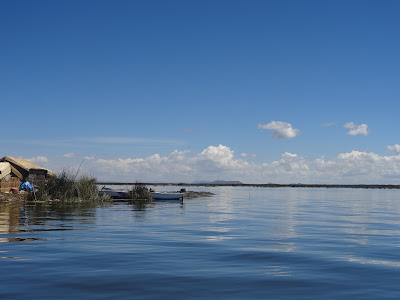After a somewhat stressful border crossing (apparently we had been 91 days in Bolivia - one day over our allowed visa, so we were questioned and had to pay a small fine) we arrived in Puno, a city right on the shoreline of Lake Titicaca. The city itself was not really anything special, and was made worse by our freezing cold hostel which made us feel like we were in a cave - no natural light, hot water, or warmth...anywhere. But it did have brilliant wifi - something much missed in Bolivia!
We booked ourselves on a tour of Lake Titicaca, with an overnight stay on one of the islands. In a group of about ten, we got a boat from the harbour, and slowly made our way across the stunning Lake. It was very hard for us to get our heads around the fact it is a Lake, and not the sea, because it is SO vast. Not even the biggest Lake in the world (but it is the highest, at 3,812m). Surrounded by mountains untouched by civilisation, it was beautiful.
We booked ourselves on a tour of Lake Titicaca, with an overnight stay on one of the islands. In a group of about ten, we got a boat from the harbour, and slowly made our way across the stunning Lake. It was very hard for us to get our heads around the fact it is a Lake, and not the sea, because it is SO vast. Not even the biggest Lake in the world (but it is the highest, at 3,812m). Surrounded by mountains untouched by civilisation, it was beautiful.
Our first stop was to Los Uros, the floating islands of Lake Titicaca. These are made from floating reeds, and are one of the main tourist attractions of the lake. Although amazing to see how people live on the islands, and how they are made, the visit actually made us feel like we were exploiting the people - or maybe even that they were exploiting us. The whole island was full of people selling us things, which we felt inclined to buy. We were told there are islands which have flat out denied tourism, which are likely to still be full of people just living, and enjoying life on the islands. But the tourist traps were a very strange experience, and one we weren't overly comfortable with.
The next island the boat took us to was Amantani, which was wonderful; truly idyllic. Here we stayed with a family, and were cooked for and looked after. The local language is that of Quechua, so communication wasn't flowing, but we all tried and happily got along. On the island live about 4,000 people, who all work together to maintain the land. There are no cars or machines on the island, so farming and agriculture is all done by hand. The people of the island were all smiling and laughing together the entire time, it was brilliant to feel like a part of their community, which they let us in to with open arms. That evening we trekked to the highest peak of the mountain and watched the sunset, before being told to don traditional dress and attend a party - which was very funny!
After breakfast in bed from our Amantani Mother, we were off on our way to the final island of our trip, Taquile. Taquile was similar to Amantani, both rich in culture and a fine local way of life. The island had some Pre-Inca ruins dotted around it, and had a lot of lovely stone archways around the towns. Here we had lunch overlooking the lake, of fresh trout caught from the waters below. We were here for Easter Sunday, and saw a parade around the square which folded in to the local Church - not quite the chocolate egg fest of the UK, but an understated and awesome ceremony, showing the whole community celebrating.
The tour was a wonderful way to see the Lake, and the Islands. We both
really enjoyed the pure silence and tranquility of each place, it was so
peaceful and surrounded by beauty.
When back on mainland Puno, we also went on a tour to Sillustani, a pre
Incan burial ground which holds lots of funeral towers, called Chullpas. We had read up
on the area before, and our tour guide took great pleasure in showing us
around and debating the difference between European and South American
Archaeology - something our old Professors, and Molly would have been very impressed (or amused) by!
We also visited a brilliant Coca museum in Puno, where again we dressed up in traditional dress - this time celebratory! Here's a picture for you all!
















Fantastic yet again darling - stunning photos - what experiences!! Keep safe. xx
ReplyDeleteaoidsh
ReplyDeleteLovely words and photos Kt, can't wait to join in !! Padre x
ReplyDelete